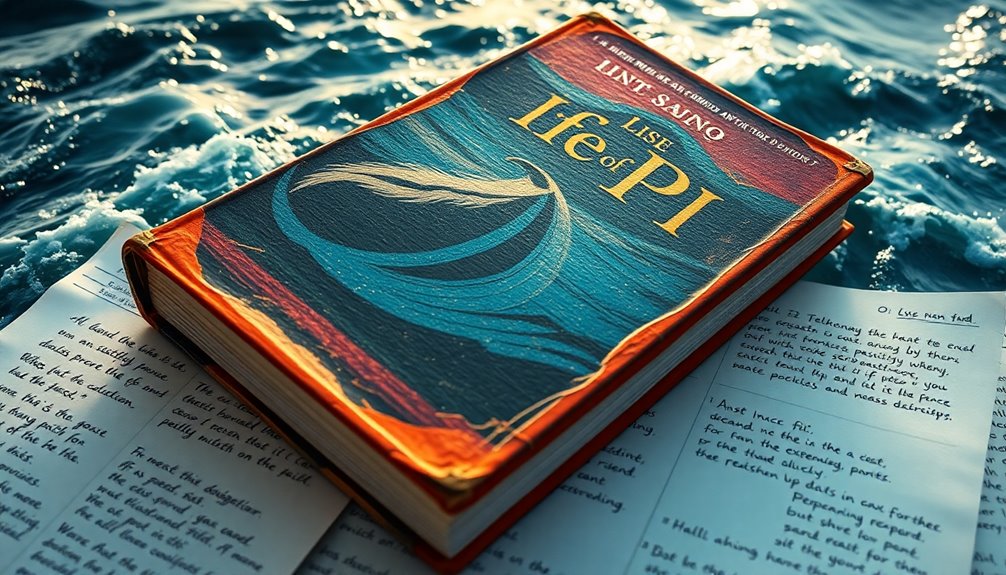Readers are enchanted by "Life of Pi," drawn in by its imaginative storytelling and rich philosophical themes. Many reflect on Pi's incredible journey of survival with a Bengal tiger, feeling a profound connection to his struggles and growth. The dual narratives spark debates about truth and coping mechanisms, keeping you engaged at every twist. Fans appreciate its exploration of faith, resilience, and personal beliefs, often finding their own insights mirrored in Pi's experiences. As you explore these various interpretations, you'll uncover even more depth that this extraordinary tale has to offer.
Overview of the Novel

In "Life of Pi," you'll find yourself immersed in the extraordinary journey of Pi Patel, a 16-year-old boy whose life takes a dramatic turn after a shipwreck leaves him stranded on a lifeboat with a Bengal tiger named Richard Parker.
The novel, published in 2001, intricately blends adventure, survival, and spirituality, showcasing Pi's incredible struggle against the odds. As he faces the challenges of life at sea, you witness his unwavering faith and resilience. The themes of resilience and personal growth resonate deeply, illustrating how Pi's journey embodies the essence of overcoming challenges. Similar to characters in "The Book Thief," Pi's journey exemplifies the power of resilience in the face of adversity.
Pi's background in a zoo in Pondicherry, India, equips him with unique insights into animal behavior, which becomes essential in his survival. Throughout his ordeal, he learns to coexist with Richard Parker, turning their relationship into a powerful symbol of hope and companionship.
The story presents two versions of Pi's survival, one featuring animals and the other devoid of them, inviting you to question the nature of truth and storytelling.
"Life of Pi" won the Man Booker Prize in 2002 and has captured audiences through its adaptation into a successful film.
This tale not only explores survival but also investigates the significance of faith and the narratives we create to make sense of our experiences. Additionally, the novel emphasizes the importance of companionship in overcoming life's challenges and illustrates how relationships can shape our journey through adversity.
Themes and Philosophical Insights
"Life of Pi" takes you beyond mere survival, inviting you to explore profound themes and philosophical insights woven throughout Pi's journey. At its core lies an intricate examination of belief, where Pi practices Hinduism, Islam, and Christianity simultaneously. This rich tapestry of faith highlights the complexity of spirituality and the importance of personal interpretation in shaping one's beliefs. Coates' exploration of identity and culture resonates with Pi's multifaceted faith journey, emphasizing the significance of understanding oneself in the context of broader societal influences.
Pi's harrowing struggle against despair at sea serves as a powerful metaphor for internal growth. His journey illustrates how adversity often catalyzes spiritual awakening, pushing you to confront doubt and embrace hope. The necessity of a leap of faith becomes evident, emphasizing that meaningful religious experiences often emerge from moments of uncertainty. This theme mirrors Coates' urging to confront uncomfortable truths about race and privilege, encouraging a deeper examination of one's beliefs and experiences. Furthermore, the resilience demonstrated by Pi in his journey reflects the transformative power of storytelling, showcasing how narrative can guide individuals through their challenges.
Moreover, the narrative employs Christian metaphors that reflect themes of maturity and humanity's quest for existential meaning. Through Pi's experiences, you're prompted to contemplate the miraculous nature of religious encounters and how they influence your perception of reality.
Ultimately, "Life of Pi" encourages you to reflect on your own beliefs and the intricate relationship between struggle and personal growth in the pursuit of spirituality. Additionally, the narrative resonates with themes of healing and empowerment, illustrating how personal challenges can lead to transformative experiences that inspire others.
Reader Reactions and Interpretations

Readers immerse themselves in "Life of Pi" with varying interpretations, particularly regarding Pi's two survival stories. Some view the animal representation as a coping mechanism for trauma, while others consider it a profound spiritual journey. This divergence in reader reactions highlights how Yann Martel's narrative can evoke different meanings, leading to rich discussions about faith and existence.
Mixed reviews reveal disagreements on whether Martel intended for you to choose between the two versions of the story. Those who criticize Freudian interpretations argue they oversimplify the book's depth and complexity. Instead, many find that engaging with the narrative encourages reflection on personal insights and belief systems. The exploration of class struggles in "David Copperfield" mirrors the complexities of personal growth and resilience depicted in Pi's journey. Additionally, the novel's intricate themes of betrayal and deception resonate with readers, drawing parallels to the complex narratives found in works like "The Green Sister."
Ultimately, the varied interpretations surrounding Pi's survival tales showcase the novel's ability to provoke thought. As you explore these themes, you may discover how your own experiences influence your understanding of the story. In a similar vein, the exploration of generational poverty in "A Tree Grows in Brooklyn" underscores the universal struggles of growing up.
The interplay between survival, faith, and personal interpretation contributes greatly to the book's status as a literary classic. So, whether you lean toward one interpretation or the other, "Life of Pi" invites you to ponder the nature of truth and belief in a uniquely personal way.
Narrative Style and Structure
Through a non-linear storytelling approach, Yann Martel intricately weaves together past and present events, enriching the narrative's depth and complexity. This technique invites you to engage with Pi's journey on multiple levels, prompting deep reflection on the subjective nature of truth. The exploration of totalitarian regimes and control in dystopian literature echoes the oppressive challenges Pi faces during his survival.
- You'll encounter two distinct accounts of Pi's survival: one with animals and one without.
- The initial chapters set a slow pace, allowing for a thorough understanding of Pi's background. The exploration of memory and self-reflection adds layers to Pi's experiences, echoing the complexities found in human narratives. This journey underscores the fragility of individual freedom, paralleling themes found in dystopian works.
- Italicized observations throughout the narrative enhance your connection to Pi's internal reflections.
Martel's vivid imagery and metaphorical representations, especially in the animal version of the story, enrich your reading experience. This narrative style encourages you to explore multiple interpretations, challenging you to reflect on the layers of meaning behind each event.
As you navigate the intertwining timelines, you find that the non-linear storytelling not only enhances the overall impact but also emphasizes the complexity of survival and belief. This complexity mirrors the themes of civilization vs. savagery found in works like "Lord of the Flies," where the struggle for order amidst chaos is a central conflict.
You'll realize that every twist and turn offers new insights, making the journey as significant as the destination itself. In the end, the narrative structure becomes a mirror reflecting your own thoughts about truth and existence.
Cultural and Religious Context

In "Life of Pi," you see how faith and survival intertwine as Pi draws strength from his diverse religious beliefs. His journey highlights the harmony possible between different faiths, prompting you to contemplate the ethical implications of belief in challenging times. This exploration invites you to reflect on your own spiritual path and the role it plays in shaping your reality. Furthermore, much like Louis Zamperini's story in Unbroken, Pi's resilience showcases the profound impact of hope and perseverance during dire circumstances. The narrative echoes the theme of resilience and hope found in "Navigating Through A Fine Balance," emphasizing the importance of inner strength amidst adversity. Additionally, Pi's journey can be seen as a reflection of the courage and defiance exhibited by individuals in resistance movements, inspiring you to draw parallels between personal struggles and collective actions against oppression.
Faith and Survival Dynamics
Amidst the turbulent waters of survival, Pi's journey reveals how faith intertwines with the instinct to endure. His character, Pi Patel, embodies a unique blend of beliefs drawn from Hinduism, Islam, and Christianity. This syncretic approach not only shapes his identity but also enhances his will to survive.
- Coping Mechanism: Pi's faith serves as a lifeline, offering hope during his darkest hours.
- Cultural Intersection: His upbringing in a zoo equips him with essential knowledge of animal behavior, vital for his survival.
- Personal Reflection: The narrative urges you to evaluate your own belief systems in the context of survival.
As Pi grapples with doubt and hope, his spiritual experiences provide him with the strength to face each day at sea.
The complexities of faith emerge when he questions the validity of organized religions, highlighting the significance of personal belief over dogma.
Ultimately, Pi's journey is a reflection of how faith can transform the struggle for survival into a profound exploration of one's inner self. In the face of adversity, belief becomes an essential anchor to navigate life's most challenging waters.
Interreligious Exploration and Harmony
Pi Patel's journey paints a vivid picture of interreligious exploration, showcasing how his embrace of Hinduism, Islam, and Christianity fosters a unique harmony among diverse beliefs. His spiritual identity reflects a profound understanding of interreligious dialogue, as he navigates through different belief systems with open-mindedness and curiosity.
This inclusive approach not only enriches his own faith but also encourages you, as a reader, to reflect on the validity of various religious perspectives.
As Pi faces the challenges of survival, he draws on his knowledge of animal behavior learned from his family's zoo. This connection illustrates how faith and practical wisdom intertwine, providing him with the strength to endure.
Through his experiences, you witness how belief systems can coexist, offering comfort and meaning even amid life's existential struggles.
Martel's narrative invites you to explore your own beliefs, urging a broader understanding of spirituality. By presenting a character who harmonizes multiple faiths, he highlights the importance of embracing diversity in belief systems.
Ultimately, Pi's journey encourages a deeper appreciation for interreligious dialogue, fostering unity in a world often divided by faith.
Ethical Implications of Belief
The ethical implications of belief systems unfold vividly throughout "Life of Pi," as the protagonist navigates the complex landscape of faith and morality. You'll find that Pi's journey emphasizes how intertwined spirituality and survival can be, challenging conventional notions of organized religion.
- Pi embodies a syncretic approach, blending multiple faiths.
- His survival skills hinge on understanding animal behavior and the strength of his beliefs.
- The narrative invites you to reflect on how personal experiences shape your understanding of truth.
As you read, consider how Martel critiques societal perceptions of belief. Pi's story illustrates that faith can be a vital lifeline in crises, prompting you to explore the ethical dimensions of your own beliefs.
The narrative encourages a deeper understanding of how belief systems can coexist, revealing the subjective nature of truth in spiritual experiences. Ultimately, the tale urges you to confront your views on faith, survival, and the moral complexities tied to them.
In doing so, you engage with the profound question of what it truly means to believe and the implications that come with it.
Character Development and Background
In "Life of Pi," you see how Pi's early life in a zoo shapes his understanding of survival and animal behavior.
As he faces the harsh realities of being stranded at sea, you'll witness a profound transformation from a passive boy to a resourceful survivor.
This character development is essential, as his background directly influences his relationship with Richard Parker, the Bengal tiger.
Pi's Early Life
Growing up in the vibrant setting of Pondicherry, India, Pi Patel's early life lays the foundation for his remarkable journey. Surrounded by the zoo his father owns, you see how Pi's interactions with animals shape his character and understanding of the world. His childhood is marked by an insatiable curiosity, especially about faith, which leads him to embrace multiple religions.
- Deep understanding of animal behavior
- Exploration of diverse faiths
- Development of resilience and ingenuity
These experiences foster his intellectual and spiritual growth, allowing him to learn essential survival skills that will prove significant later.
While Pi starts off as somewhat passive and sheltered, you witness his transformation through his interactions with adults and the environment around him. His exposure to different faiths—Hinduism, Islam, and Christianity—embodies a unique syncretic approach, enriching his belief system.
As his journey unfolds, the resilience he cultivates during these formative years becomes a critical part of his identity. Pi's early life not only highlights his childhood adventures but also prepares him for the extraordinary challenges that lie ahead.
Transformation at Sea
Stranded in the vastness of the ocean, Pi Patel transforms from a sheltered boy into a resourceful survivor, maneuvering both the physical and psychological challenges of life on a lifeboat with Richard Parker, the Bengal tiger. His background as the son of a zookeeper in Pondicherry equips him with essential knowledge of animal behavior, which he cleverly uses to establish dominance and coexist with the formidable creature.
Throughout this harrowing journey, Pi's multi-religious upbringing—embracing Hinduism, Christianity, and Islam—provides him with spiritual strength, offering solace and coping mechanisms in times of despair.
As he faces isolation and the struggle for survival, you witness his profound character evolution; he transforms from a passive boy into a determined survivor, confronting existential questions and moral dilemmas along the way.
These challenges force you to reflect on the essence of humanity and the instinct to survive. Pi's experiences deepen his understanding of himself and his place in the universe, showcasing how adversity can fuel personal transformation.
Ultimately, his journey isn't just about physical survival but about embracing the complexities of life itself.
Reader Impressions

Readers often find "Life of Pi" a slow burn at first, but many quickly realize this pacing is essential for developing the characters and themes. As you journey with Pi, you'll appreciate the meticulous character development that lays the groundwork for his incredible story of survival.
- Emotional engagement peaks once Pi is stranded at sea, drawing you deeper into the narrative.
- The book challenges your perceptions of a simple children's tale, revealing complex themes and philosophical insights.
- Diverse readers express a desire for more exploration of Pi's journey beyond the main narrative.
The thematic depth of "Life of Pi" invites contemplation about faith and the nature of storytelling. As you navigate through Pi's trials, you'll find that the ending prompts reflection on deeper meanings, leaving you with questions about existence and belief.
This engaging journey transforms what seems like a straightforward adventure into a profound exploration of the human spirit. Ultimately, you'll discover that "Life of Pi" isn't just a story about a boy and a tiger; it's a powerful tale that resonates long after the last page is turned.
Writing Style and Language
Immersing yourself in Yann Martel's "Life of Pi" reveals a writing style rich with vivid imagery and descriptive language that brings the protagonist's experiences to life, especially during his harrowing survival ordeal at sea.
You'll find yourself captivated by the lush details that evoke the sights, sounds, and feelings of Pi's journey. The narrative employs a non-linear structure, blending background information with present events, which adds depth and complexity to the storytelling.
Martel's unique narrative style features italicized observations that provide insight into Pi's thoughts and emotions, enhancing your connection to his struggles.
While the pacing may feel slow in the early chapters, this deliberate approach is crucial for character development, allowing you to fully understand Pi before diving into the intense action of survival.
As you read, you'll notice how Martel artfully intertwines the themes of faith, survival, and the nature of storytelling itself, prompting you to reflect on these profound ideas.
This masterful combination of descriptive language and innovative structure guarantees that "Life of Pi" remains an unforgettable literary experience.
Critical Reception and Impact

Critics have frequently lauded "Life of Pi" for its imaginative storytelling and philosophical richness, which helped it win the Man Booker Prize in 2002. The novel's critical reception highlights its profound impact on readers and its status as a modern literary classic.
Here are a few key points about its reception and impact:
- Imaginative storytelling that captivates diverse audiences.
- Philosophical depth that invites reflection on faith and survival.
- Complex narrative structure encouraging repeated readings for new insights.
Since its release, "Life of Pi" has resonated with many, making it a staple in discussions about contemporary literature.
Its unique narrative invites readers to explore complex themes, enriching their understanding with each reading.
While the 2012 film adaptation received mixed reviews—some felt it didn't capture the book's full depth—it still broadened the novel's reach and continued discussions surrounding its themes.
Overall, the combination of its compelling narrative and philosophical inquiries guarantees that "Life of Pi" remains influential, sparking conversations and inspiring readers long after its initial publication.
The book's lasting impact is truly undeniable.
Symbolism and Motifs
Exploring the rich symbolism and motifs in "Life of Pi" reveals layers of meaning that deepen the narrative experience. The character of Richard Parker symbolizes both the primal instinct for survival and the complex relationship between fear and companionship. As you navigate Pi's journey, you'll see how their bond challenges your understanding of what it means to coexist with the wild.
The lifeboat acts as a microcosm of society, emphasizing isolation and the struggle for harmony between humans and animals. Meanwhile, the ocean serves as a powerful motif, embodying the vastness of the unknown. It reflects life's unpredictability and your own quest for meaning in a chaotic world.
Pi's exploration of multiple religions introduces themes of spiritual diversity, showcasing humanity's quest for understanding amidst complexity. This rich tapestry of beliefs invites you to ponder your own spiritual journey.
Finally, the act of storytelling emerges as an essential survival mechanism. Through Pi's narratives, you'll discover how storytelling shapes perceptions of reality and personal experiences, making it crucial in his struggle against despair.
In "Life of Pi," symbolism and motifs intertwine to create a profound exploration of existence and resilience.
Life Lessons From Pi

In "Life of Pi," you see how faith and resilience are essential when facing life's toughest challenges.
Pi's journey teaches you that survival isn't just about physical endurance, but also about spiritual growth and adaptability.
As you reflect on his experiences, you'll discover how these lessons can transform your own perspective on adversity and belief.
Faith and Resilience
Resilience often emerges in the most unexpected places, and Pi Patel's journey in *Life of Pi* is a powerful demonstration of this truth. Stranded for 227 days on a lifeboat with a Bengal tiger, Richard Parker, you witness how Pi's faith and ingenuity fuel his survival against all odds. His exploration of multiple religions underscores the role of spirituality in finding strength during adversity.
- Faith is a powerful anchor, providing hope when doubt creeps in.
- Storytelling becomes an essential tool for Pi, helping him cope with trauma.
- Resilience isn't just about physical survival; it's also about embracing emotional and spiritual growth.
Through Pi's internal struggles, you see that maintaining belief in the divine and the possibility of miracles can illuminate even the darkest moments. His narrative emphasizes that faith in something greater can sustain you through life's challenges.
Survival and Spiritual Growth
Survival isn't just about making it through tough times; it's also a journey of spiritual growth that can reshape your understanding of life. In *Life of Pi*, you witness how Pi's struggle for survival alongside Richard Parker teaches him invaluable lessons about resilience and faith. His physical endurance is impressive, but what truly stands out is how he utilizes his inner strength to navigate trauma.
Pi's resourcefulness shines as he applies his knowledge of animal behavior to establish a delicate balance with the tiger, showcasing adaptability in dire circumstances. Yet, it's his unwavering faith that serves as a beacon of hope during moments of despair.
This journey illustrates that survival isn't merely about enduring physical challenges; it's about embracing a profound spiritual awakening.
As you reflect on Pi's dual story of survival—one with animals and one without—you realize that spirituality can transform your perception of reality and suffering.
Ultimately, *Life of Pi* conveys that both survival and spiritual growth are intertwined, enriching your understanding of existence and highlighting the importance of faith in overcoming life's most formidable obstacles.
Comparisons to Other Works
"Life of Pi" invites comparisons to several literary works that echo its themes of endurance and the intricate bond between humanity and nature. Readers often find themselves drawing parallels to other narratives that explore survival, personal journeys, and the resilience of the human spirit.
Here are a few notable comparisons:
- "The Old Man and the Sea": Both tales highlight survival against nature and the deep connection between man and his environment.
- "Big Fish": This work shares a fantastical storytelling approach, exploring subjective truth in personal narratives much like Pi's journey.
- "The Alchemist": Both novels emphasize personal journeys and the pursuit of dreams through spiritual awakening.
Moreover, "The Road" and "Life of Pi" resonate with themes of human resilience amidst existential challenges.
Similarly, readers note the narrative techniques in "The Book Thief," where storytelling becomes a means of coping with trauma, akin to Pi's experiences.
These works collectively enrich your understanding of how storytelling can illuminate the complexities of survival and the human condition.
Reader Recommendations

If you're looking for a book that resonates with readers of all ages, "Life of Pi" is a perfect choice.
Its engaging narrative and profound themes make it easy to compare with classics like "Big Fish" and "The Old Man and the Sea."
You'll likely find yourself reflecting on survival and faith long after you turn the last page.
Wide Audience Appeal
While many stories focus solely on adventure, "Life of Pi" enthralls readers with its rich tapestry of faith and survival, making it resonate across generations and cultures.
Its wide audience appeal comes from the way it intertwines engaging storytelling with profound philosophical reflections.
Here are a few reasons why you'll want to immerse yourself in this thought-provoking read:
- Universal Themes: The exploration of belief systems and survival invites readers from diverse backgrounds to connect with Pi's journey.
- Emotional Depth: The intricate narrative style evokes a range of feelings, prompting readers to reflect on their own experiences and beliefs.
- Engagement and Reflection: Many readers express a desire for deeper exploration of Pi's adventure, showcasing the book's lasting impact.
Similar Thematic Reads
For those enchanted by the themes of faith, survival, and introspection found in "Life of Pi," there's a wealth of similar reads waiting to be explored.
One highly recommended book is "The Alchemist" by Paulo Coelho, which investigates the pursuit of personal legends and dreams, echoing Pi's own spiritual journey. If you enjoy intertwining fantastical elements with profound life lessons, "Big Fish" by Daniel Wallace will resonate with you, offering a unique storytelling experience.
For a classic take on struggle and survival, Ernest Hemingway's "The Old Man and the Sea" mirrors Pi's harrowing experience at sea, capturing the essence of resilience.
On a different note, Cormac McCarthy's "The Road" presents a stark exploration of human resilience and moral dilemmas in a post-apocalyptic world, reflecting the survival themes you might appreciate.
Lastly, "Daughters of Shandong" by Xiaolu Guo offers a rich cultural context and an introspective journey, resonating with the multifaceted themes of faith and identity present in Pi's narrative.
These reads will deepen your understanding of similar themes while providing engaging stories.
Discussion Questions
Engaging with "Life of Pi" invites rich discussion questions that challenge your perceptions of truth, ethics, and survival. Each aspect of Pi's journey opens doors to profound conversations. Here are some thought-provoking questions to reflect upon:
- How does the Author's Note influence your understanding of storytelling and truth in Pi's narrative?
- In what ways does Pi's experience with Richard Parker force you to confront your views on survival and the ethics of human behavior during dire situations?
- What role does faith play in Pi's resilience, and how does it shape your interpretation of suffering and doubt?
These questions not only explore the complex layers of Pi's ordeal but also invite you to reflect on your beliefs.
By examining the ethical implications of animal rights through the analogy of the zoo, you can analyze the balance between freedom and captivity.
Additionally, the themes of food and cultural identity throughout the story encourage discussions about shared experiences.
As you ponder these questions, reflect on how they relate to your understanding of truth and the multifaceted nature of human existence, particularly in the face of adversity.
Personal Reflections on the Story

Many readers find that "Life of Pi" leaves a lasting impact long after they turn the last page. You might initially feel skeptical about the plot's believability, but as you dive deeper, you'll discover the narrative's rewarding complexity. The emotional engagement peaks when Pi is stranded at sea, making you invested in his survival against all odds.
As you continue reading, you'll notice the pace may feel slow at first, yet this allows for rich character development and thematic depth. Reflecting on the themes of faith and storytelling, you'll likely find yourself questioning your own beliefs and interpretations. The dual narratives challenge you to think critically, leading to diverse personal insights that spark meaningful discussions.
Ultimately, "Life of Pi" is more than just a tale of survival; it's a profound exploration of faith and existence. You'll leave with a sense of wonder, contemplating the layers of meaning long after the final chapter.
This book encourages you to embrace complexity and consider what you truly believe, making your reading experience both enlightening and transformative.
Conclusion
In the end, "Life of Pi" isn't just a story of survival; it's a journey through faith and doubt, light and darkness. As you close the book, you might find yourself torn between reality and imagination, just like Pi. This extraordinary tale invites you to explore the depths of your beliefs while embracing the absurdity of life. So, whether you see Pi's tale as a miracle or mere fiction, it's a narrative that challenges your perspective.



